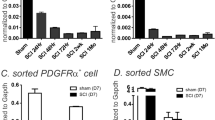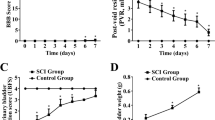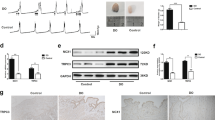Abstract
Detrusor overactivity threatens the renal function of patients with spinal cord injury. Suppressing N-methyl-D-aspartate receptors is known to improve detrusor overactivity in rats with spinal cord injury, whereas kynurenic acid, the endogenous antagonist of N-methyl-D-aspartate receptors, is irreversibly synthesized by kynurenine aminotransferases (KATs). In this study, we investigated whether replication-defective herpes simplex virus vector-mediated gene transfer of human KAT II could treat detrusor overactivity by injecting the vectors into the rat bladder wall 1 week after spinal cord injury. Three weeks after injection, we evaluated the cystometry and gene expression of KAT II in L6-S1 dorsal root ganglia. The results showed that the vectors are transported to L6-S1 dorsal root ganglia and upregulate the expression of KAT II, and that they also improve the detrusor overactivity and voiding efficiency. We also proved that N-methyl-D-aspartate receptors were blocked by kynurenic acid in the extracellular solution or the vector-mediated gene transfer of KAT II in cultured rat neurons of L6-S1 dorsal root ganglia by whole-cell patch clamp to explore the mechanisms of gene therapy. Therefore, replication-defective herpes simplex virus vector-mediated KAT II inhibits detrusor overactivity in spinal cord-injured rats, possibly by suppressing N-methyl-D-aspartate receptors in bladder afferent pathways.
This is a preview of subscription content, access via your institution
Access options
Subscribe to this journal
Receive 12 print issues and online access
$259.00 per year
only $21.58 per issue
Buy this article
- Purchase on Springer Link
- Instant access to full article PDF
Prices may be subject to local taxes which are calculated during checkout





Similar content being viewed by others
References
de Groat WC, Yoshimura N . Changes in afferent activity after spinal cord injury. Neurourol Urodyn 2010; 29: 63–76.
Castro-Diaz D, Taracena LJ . Detrusor–sphincter dyssynergia. Int J Clin Pract Suppl 2006; 151: 17–21.
Yoshiyama M, Nezu FM, Yokoyama O, Chancellor MB, de Groat WC . Influence of glutamate receptor antagonists on micturition in rats with. Exp Neurol 1999; 159: 250–257.
Watanabe T, Constantinou CE . Analysis of pressure/flow characteristics in the female rat and their pharmacologic modulation. Neurourol Urodyn 1996; 15: 513–527.
Yoshiyama M, Roppolo JR, de Groat WC . Alteration by urethane of glutamatergic control of micturition. Eur J Pharmacol 1994; 264: 417–425.
Elmslie KS, Yoshikami D . Effects of kynurenate on root potentials evoked by synaptic activity and amino acids in the frog spinal cord. Brain Res 1985; 330: 265–272.
Hilmas C, Pereira EF, Alkondon M, Rassoulpour A, Schwarcz R, Albuquerque EX . The brain metabolite kynurenic acid inhibits alpha7 nicotinic receptor activity and increases non-alpha7 nicotinic receptor expression: physiopathological implications. J Neurosci 2001; 21: 7463–7473.
Iwabuchi N . Sacral glutamatergic transmission in the descending limb of the micturition reflex in the cat. Fukuoka Igaku Zasshi 1997; 88: 30–38.
Guidetti P, Okuno E, Schwarcz R . Characterization of rat brain kynurenine aminotransferases I and II. J Neurosci Res 1997; 50: 457–465.
Kiss C, Ceresoli-Borroni G, Guidetti P, Zielke CL, Zielke HR, Schwarcz R . Kynurenate production by cultured human astrocytes. J Neural Transm 2003; 110: 1–14.
Yoshimura N, Miyazato M, Sasaki K, Yokoyama H, Oguchi T, Chancellor MB et al. Gene therapy for lower urinary tract dysfunction. Int J Urol 2013; 20: 56–63.
Manservigi R, Argnani R, Marconi P . HSV recombinant vectors for gene therapy. Open Virol J 2010; 4: 123–156.
Miyazato M, Sugaya K, Goins WF, Wolfe D, Goss JR, Chancellor MB et al. Herpes simplex virus vector-mediated gene delivery of glutamic acid decarboxylase reduces detrusor overactivity in spinal cord-injured rats. Gene Therapy 2009; 16: 660–668.
Miyazato M, Sugaya K, Saito S, Chancellor MB, Goins WF, Goss JR et al. Suppression of detrusor-sphincter dyssynergia by herpes simplex virus vector mediated gene delivery of glutamic acid decarboxylase in spinal cord injured rats. J Urol 2010; 184: 1204–1210.
Keast JR, de Groat WC . Segmental distribution and peptide content of primary afferent neurons innervating the urogenital organs and colon of male rats. J Comp Neurol 1992; 319: 615–623.
Mallory B, Steers WD, de Groat WC . Electrophysiological study of micturition reflexes in rats. Am J Physiol 1989; 257: R410–R421.
de Groat WC, Yoshimura N . Mechanisms underlying the recovery of lower urinary tract function following spinal cord injury.Prog Brain Res 2006; 152: 59–84.
Cheng CL, Ma CP, de Groat WC . Effect of capsaicin on micturition and associated reflexes in chronic spinal rats. Brain Res 1995; 678: 40–48.
Seki S, Sasaki K, Igawa Y, Nishizawa O, Chancellor MB, de Groat WC et al. Suppression of detrusor-sphincter dyssynergia by immunoneutralization of nerve growth factor in lumbosacral spinal cord in spinal cord injured rats. J Urol 2004; 171: 478–482.
Turski WA, Gramsbergen JB, Traitler H, Schwarcz R . Rat brain slices produce and liberate kynurenic acid upon exposure to L-kynurenine. J Neurochem 1989; 52: 1629–1636.
Li JQ, Chen SR, Chen H, Cai YQ, Pan HL . Regulation of increased glutamatergic input to spinal dorsal horn neurons by mGluR5 in diabetic neuropathic pain. J Neurochem 2010; 112: 162–172.
Jin XG, Chen SR, Cao XH, Li L, Pan HL . Nitric oxide inhibits nociceptive transmission by differentially regulating glutamate and glycine release to spinal dorsal horn neurons. J Biol Chem 2011; 286: 33190–33202.
Acknowledgements
This study was supported by National Natural Scientific Foundation of China (81270847, to LL) and Joint Training Foundation for Postgraduates at home and abroad of Beijing Colleges and Universities (2012, to CJ). We thank Xiulin Zhang (Department of Pharmacology and Cell Biology, University of Pittsburgh, Pittsburgh, PA, USA) for the technical support in the patch-clamp test.
Author information
Authors and Affiliations
Corresponding author
Ethics declarations
Competing interests
The authors declare no conflict of interest.
Rights and permissions
About this article
Cite this article
Jia, C., Yoshimura, N. & Liao, L. Herpes simplex virus vector-mediated gene transfer of kynurenine aminotransferase improves detrusor overactivity in spinal cord-injured rats. Gene Ther 21, 484–489 (2014). https://doi.org/10.1038/gt.2014.19
Received:
Revised:
Accepted:
Published:
Issue Date:
DOI: https://doi.org/10.1038/gt.2014.19
This article is cited by
-
Increasing bladder capacity by foot stimulation in rats with spinal cord injuries
BMC Urology (2017)
-
Improvement in detrusor-sphincter dyssynergia by bladder-wall injection of replication-defective herpes simplex virus vector-mediated gene delivery of kynurenine aminotransferase II in spinal cord injury rats
Spinal Cord (2017)



